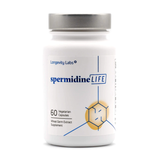
All living beings, whether plants, animals, or humans, fluctuate function and behavior in accordance with the time of day and physiological chemical changes. Traditionally this "circadian rhythm“ fluctuates over a 24 hour period.
Just as with many other substances and processes in the body, spermidine levels in cells increase and decrease in accordance with the circadian rhythm.
The Circadian Rhythm
As we traditionally think of the circadian rhythm, we are aware that as evening sets in, body temperature lowers to bring on restful sleep. As the sun rises, body temperature rises to prepare for the day ahead. However, this „internal clock“ also assists in the control of our blood pressure, heart rate, hunger and digestion, and muscular and mental performance. As mammals, our "clock“ is located in the hypothalamus of our brains. This area of the brain is where the optic nerve of our eyes connects with our internal mechanisms, collecting external information to influence this cycle. As information is collected through our eyes, this internal mechanism controls the production of proteins related to these physiological states, known as "protein expression waves.“ Our internal "clock“ activates the formation of melatonin when it gets dark in the evening while reducing digestive enzymes, making us feel "tired.“
While light tends to be the most important input in this process, the seasons, food intake, and social stimuli also play a role in regulating this process. Interestingly, even during experiments on animals where these "inputs," such as light or social stimuli, were restricted, physiological rhythms still developed a cadence between 19 and 29 hours long.
Disturbances in the body’s traditional circadian rhythm can lead to a drop in muscular or mental performance, gastrointestinal irregularities, sleep irregularity, respiratory problems, and even pain. Along with sleep disorders, shift work, and/or jet lag, age can also play a role in disturbing the regular functioning of the body’s circadian rhythm.
Spermidine and the Circadian Rhythm
A recently published study has shown that increasing the spermidine levels in older mice may help regulate and improve functions of the circadian rhythm. Scientists now suspect that spermidine is an endogenous generator that can influence the circadian rhythm in mammals (Zwighaft et al. 2015*).
While the studies are promising, or at the very least interesting, knowledge at this point has only come from mice studies as human studies are not yet available. Increased focus on the research into how spermidine interacts with humans and all mammals will certainly be a compelling story to watch in the coming years.
References
* Zwighaft, Z., Aviram, R., Shalev, M., Rousso-Noori, L., Kraut-Cohen, J., Golik, M., Brandis, A., Reinke, H., Aharoni, A., Kahana, C., and Asher, G. (2015). Cell Metab. 22, this issue, 874–885.







